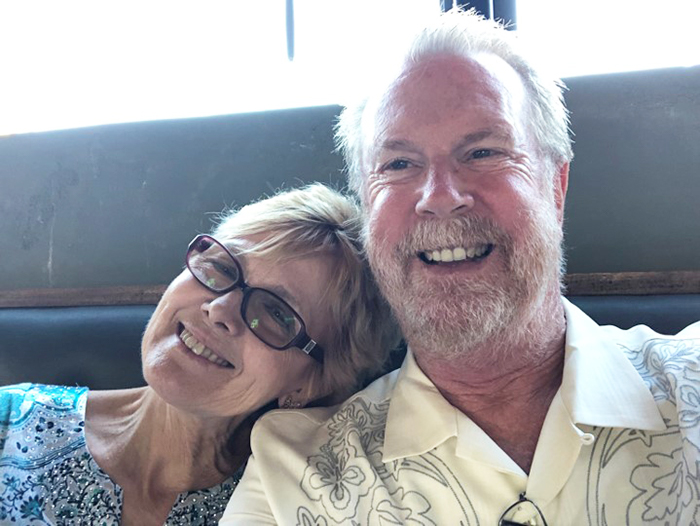Dr. Phil Schwartz loves to cook.
“My forte is trying out new things,” says Phil, supervisor and senior scientist at the CHOC Research Institute. “The more complicated, the better.”
On a recent Monday, when Phil reported to the labs and offices on the fourth floor of the CHOC Research Building for a weekly staff meeting, he brought for his colleagues the confections alfajores, which are popular throughout Latin America.
Phil made the crumbly butter cookies sandwiched with a thick layer of dulce de leche (milk caramel) from scratch.
As complicated and nuanced as his cooking can get in his kitchen, so too can Phil’s work get in the labs of the CHOC Research Institute. There, he and his dozen or so colleagues strive to devise leading-edge therapies to save a child’s life or provide care that improves a child’s quality of life as they probe rare diseases, genetic and molecular disorders, infectious diseases, and neurological disorders.
Most of Phil’s work involves studying cells taken from patients with genetic diseases.
Bedside to bench to bedside
“Why are we doing this?” Phil asks. “We see really sick kids come through the hospital and for many of these kids with rare diseases, there’s nothing we can do for them because we don’t yet have the therapies. We support them however we can, but often that is not enough.
“We find out what their symptoms are and try to make their symptoms go away. In most cases, we’re not curing them. Their illnesses develop over time, and they get sicker and sicker, and many of these kids die before they’re 10 years old. There’s nothing we can do to stop that.”

The job of Research Institute scientists, Phil says, is to set up clinical programs, basic science programs, and translational science programs — research efforts that apply discoveries generated in labs to study in humans.
“We call this bedside-to-bench-to-bedside research,” Phil explains.
The scientists start with cellular models then advance to animal models — mice — to narrow down the scope of possible therapies that potentially can advance to clinical trials in humans.
They also use therapies already approved for use in humans for specific conditions and apply them to other diseases — a practice known as “off-label” therapy.
“We’ve done this a couple of times and have seen some successes,” Phil says.
Phil, who has a PhD. in neuroscience with a minor in pharmacology from the Brain Research Institute at UCLA, has seen CHOC’s research efforts transform from a pediatric clinical research unit run by the nursing department in 1996, when he joined CHOC, to a Research Institute formally established in 2003.
Today, the Research Institute has more than 500 studies in more than 30 specialties.
Physical growth
The CHOC Research Institute occupies the fourth and fifth floors of the Research Building. There’s also a vivarium on the sixth floor where research involving mice is conducted.
Changes to the fourth floor are coming, with even more research space earmarked for the approved South West Tower, a key component of CHOC’s Enterprise Master Plan, a project designed to transform CHOC from a thriving regional children’s hospital into one of the nation’s leading pediatric healthcare systems.
The nine-story Southwest Tower will have an entire floor devoted to research. Construction is set to start on the three-phase project in the fourth quarter of fiscal year 2022 and continue through the fourth quarter of fiscal year 2030.
Meanwhile, the fourth-floor lab imprint of the CHOC Research Institute, where metabolic disease and other clinical research is conducted, is set to double in size over the next two years if funding can be procured, Phil says. Also on the fourth floor are offices for research administrators and a bone marrow transplant and cord blood stem cell bank (the fifth floor houses hematology research and advanced hematology diagnostic labs).
The sought-after funding will meet the Research Institute’s objective to provide a modernized physical infrastructure that meets up-to-date engineering requirements to conduct cutting-edge biomedical research.
CHOC’s Metabolic Rare Disease Program, developed by Phil and Dr. Jose Abdenur, medical director of metabolic disorders, is emblematic of the bedside-to-bench-to-bedside approach. Phil says.
“The Metabolic Rare Disease Program now is at the forefront of everybody’s thinking here,” Phil says.
CHOC, he adds, is applying to become a Center of Excellence with the National Organization of Rare Disorders (NORD), a classification that would “tell the world to send their patients to CHOC – that we can treat them here,” Phil says.
A variety of uses
Phil gives a tour of the fourth floor.
The secure space includes a wet lab where bench work and analysis of biological tissues is conducted. There are banks of tanks of gases and refrigerators and freezers that contain thin slices of mice brains and living human cells that can remain viable for at least 20 years.
“This is really great for taking samples from patients and studying them over time to find out what disease they have and what we can do about it,” Phil says.
One freezer contains some 20,000 cell and tissue samples representing around 300 patients – with some samples dating back nearly three decades.
There’s a biohazard room where scientists work with human cells that are treated as infectious material since they don’t know what viruses they may find.
He shows off a flow cytometer, which allows scientists to measure properties of cells in a rapidly flowing fluid stream. The machine can make measurements of cells in solution as they pass by the instrument’s laser at rates of 10,000 cells per second.
“Virtually everything we do here involves cells,” says Phil, who is nationally recognized for his work on the use of stem cells to understand the neurobiological causes of neurodevelopmental disorders that have a genetic basis.
From skin cells to brain cells
Phil and other Research Institute scientists at CHOC are growing brain cells from skin cells, which allows them to analyze in a dish in a laboratory how the brain cells communicate with each other, Phil explains.
“We can’t analyze that in a living child,” he says. “The best way to do this is to make the cells in a dish the laboratory equivalent of a brain. This will tell us what parts of the cells’ physiology are not working properly. Understanding this may give us targets for therapy.”
In addition to supervising the Neuroscience Laboratories of the CHOC Research Institute, Phil is the director of the National Human Neural Stem Cell Resource (NHNSCR) in the institute’s Center for Translational Research. The NHNSCR helps drive national and international research on cellular models of disease.

Phil, who also is a member of the UC Irvine Stem Cell Research Center, says new cellular research may lead to diagnosing autism with a simple blood test, for example.
The causes of autism are generally unknown, says Phil, who earned Bachelor of Science degrees in biology and chemistry from Seattle University.
“We think it has to do with the way the brain cells communicate with each other,” he says. “There’s a strong genetic predisposition to autism, although influences during pregnancy cannot be ruled out.”
CHOC scientists and their worldwide collaborators are working to find a biological cause of autism so they can have a diagnostic tool that is not just behavioral — like a blood test, Phil says.
“With that knowledge,” he explains, “we can also develop new therapies and drugs.”
Examples of research
Some of the work doctors and scientists in the research institute have done illustrates that point.
For example, Dr. Raymond Wang has been using an off-label drug to treat cholesterol synthesis disease. He is using a compound found in the odor-masking spray Febreze on patients that has been shown to reduce cholesterol levels in their cells.
In another case, the condition of a patient who had an extremely rare disease characterized by high blood levels of methionine and extremely high levels of toxic S-AdenosylHomocysteine (SAH), which interferes with vital cellular growth, immediately improved when he was put on a delicate protein-restricted diet.
Phil currently is working on a study that shows that restricting oxygen can modify the course of a disorder involving mitochondria, which produce energy in cells. A drug approved for treating anemia that mimics this effect has shown to be effective, he says.
Other interests
Phil says he plans to retire in June 2022 after 26 years at CHOC.
He and his wife, Vicki, a retired elementary school teacher, plan to spend more time with their six grandchildren and five children.

They love to travel, and Phil enjoys working with his hands. His hobbies include construction projects, gardening, and – of course – cooking.
“The entire outside of our house is a wall-to-wall fruit and vegetable garden,” he says.
Phil will leave CHOC, he says, knowing the Research Institute is in a great spot.
“When I step out the door,” he says, “I want the folks here to be well situated and have all the necessary equipment to do their work. When I leave, I want everything to be good to go.”

Learn about pediatric research and clinical trials at CHOC




